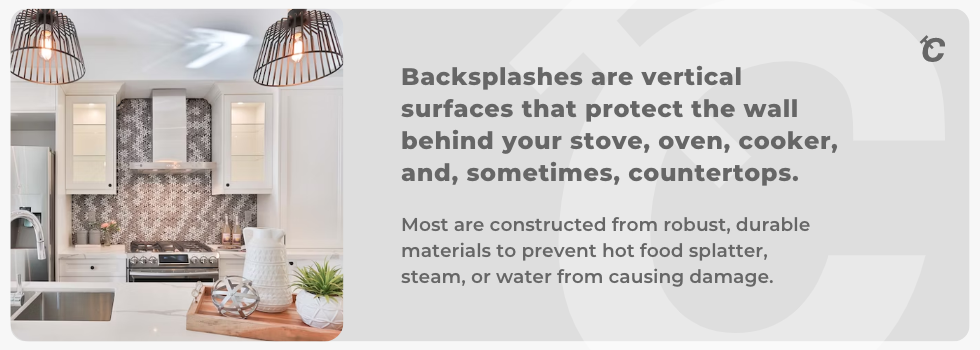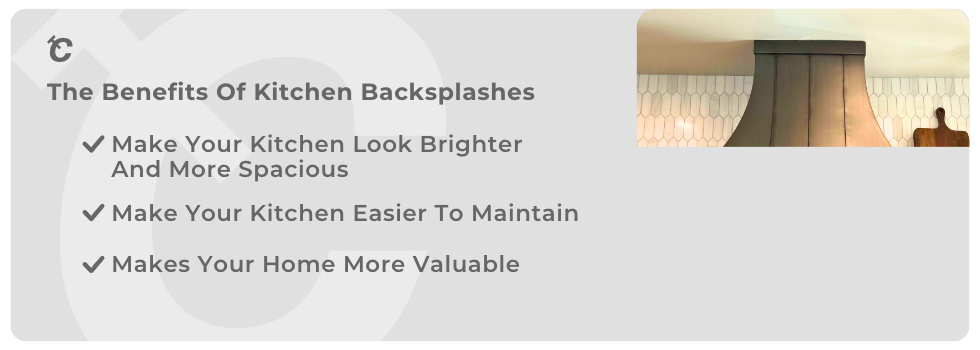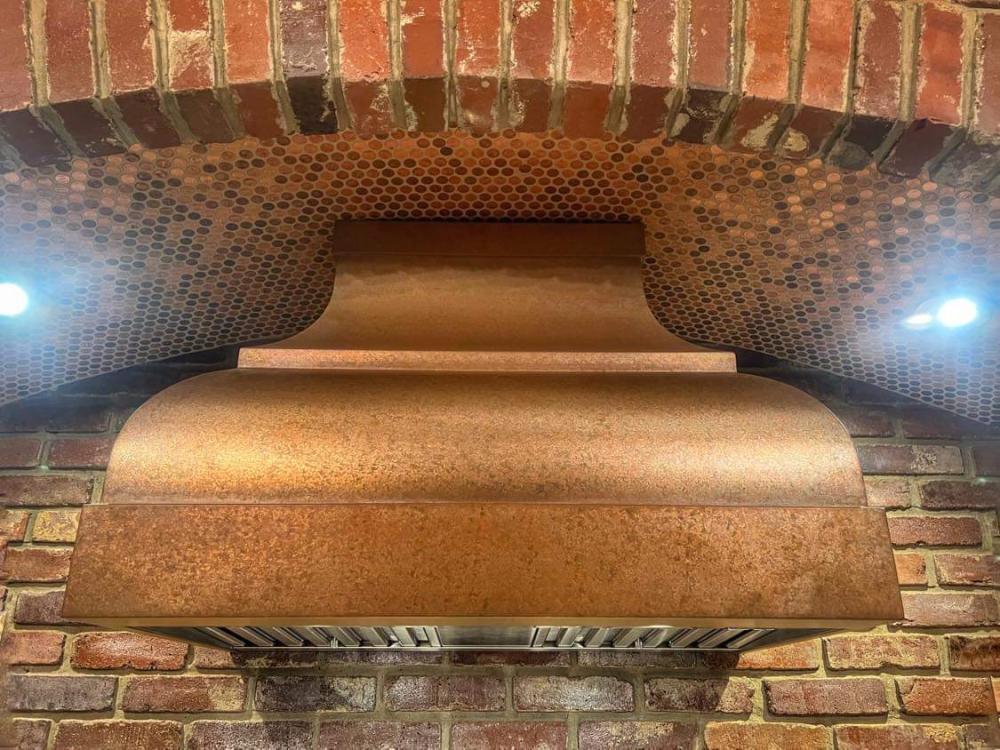
Backsplashes are vertical surfaces that protect the wall behind your stove, oven, cooker, and, sometimes, countertops. Most are constructed from robust, durable materials to prevent hot food splatter, steam, or water from causing damage.
The benefits of backsplashes are considerable. However, finding kitchen ideas that incorporate them isn’t always easy.
That’s where this blog helps. We list dozens of backsplash ideas you can implement at home today. By the end of this post, you will understand what works, what doesn’t, and how to get started.
But first, where did backsplashes come from, and why do people insist on them in modern kitchen renovations?
Where Did Kitchen Backsplashes Come From?
The first backsplashes of modern times were basic. Most only rose a couple of inches from the rear of the cooker or were incorporated into it by the manufacturer, leaving the rest of the wall exposed. Some early kitchens didn’t have a backsplash at all and relied on paint or wallpaper.
Interestingly, many ancient cultures, such as the Greeks, Babylonians, and Egyptians, used backsplashes in their dwellings. But they were expensive. Not everyone could afford them. As such, their popularity waxed and waned throughout history.
Tile backsplashes became more affordable in the nineteenth century as citizens in Britain, the U.S., and the Netherlands became more affluent. Factories churned out vast quantities at low cost, helping to make them more affordable. As their popularity grew, tiles began driving various artistic and architectural movements, such as Modernism, Art Deco, Art Nouveau, and Arts and Crafts.
George C. Heins and Christopher Grant LaFarge used specially-designed tiles for the first New York City subway station in 1904. The white rectangular shape reflected light to brighten stations and improve hygiene. Little did they know that their design would prove a hit among American householders looking for the same benefits in their bathrooms and kitchens.

As kitchen design continued to evolve and materials became less expensive, designers and architects began experimenting with backsplash variations. Following the invention of stainless steel in 1911, commercial kitchens in cities used the material to protect kitchen walls from intense, daily cooking activities. Later in the century, when tempered glass became available, high-end restaurants and gastro-kitchens started using it to stop food from splattering drywall and brickwork behind.
Today, the backsplash landscape is highly varied. Multiple material options are available, including brick, glass, copper, stainless steel, tiles, and stone. Because of this, you are much more likely to find a kitchen backsplash design you love.
The Benefits Of Kitchen Backsplashes
The benefits of kitchen backsplashes are broader than they might first appear. Yes, they protect your walls from food splatter but they offer other perks, too.
Make Your Kitchen Look Brighter And More Spacious
For instance, a big reason people get backsplashes is that they help make the kitchen look brighter and more spacious. Backsplashes create the illusion of depth by reflecting more light into the room.
Take stainless steel. It can reflect up to 49 percent of visible light because of its high chromium content, while white tiles can reflect up to 80 percent of light hitting them, diffusing it around the room.
Contrasting backsplash material with surrounding cabinets and furnishings can create a clean, classic look that evokes spaciousness. Adding mosaic elements makes the kitchen feel less restrictive and more welcoming.

Make Your Kitchen Easier To Maintain
Another backsplash benefit is that they make your kitchen easier to maintain. Backsplashes eliminate the need to repaint or repair wall sections damaged by food splatter. They also prevent walls from getting wet, stopping the growth of mold and mildew, which are time-consuming and expensive to fix.
Steel, copper, and tile backsplashes are easy to clean. Just wipe them down with mild soap and a wet cloth.
Makes Your Home More Valuable
Another benefit of backsplashes is making your home more valuable to potential buyers. High-end backsplashes that use premium materials add value by themselves. People are willing to pay more for properties incorporating ceramic tile, natural stone, or metal. They also protect your home from damage, improving your negotiating position.
20 Backsplash For Kitchen Ideas
Now we’ve discussed where backsplashes came from and the benefits they offer, we’re ready to look at some specific concepts. Read all about them below.
Subway-Style Tiles
If you’re struggling with backsplash tile kitchen ideas, this might be the inspiration you need. This designer has used classic subway tiles to create a backsplash for this stainless steel oven and matching range hood.
Notice how the tiles reflect most of the incoming light. The effect is almost mirror-like, helping to brighten the kitchen and make it feel more welcoming. The brilliant white color choice pairs well with the neutral cabinets and lime paint encircling the hood.
Marble Backsplash
Also, consider the marble backsplash shown here. Marble isn’t necessarily the best material for a backsplash because the raw rock is porous. But properly treated, it can create stunning interiors, particularly when you pair it with a matching island, as shown here.
Marble comes in various grains and colors, which makes it highly versatile. Red, white, cream, black, brown, pink, yellow, green, and gray marbles are available.
What’s more, no two marble slabs are the same. The grain, texture, patterns, and color is always slightly different, meaning your kitchen will always be unique. Nobody can copy you.
Black Diamond Tiles
This example is another of our favorite backsplash tile ideas. Here, the designer chose to line the back of the cooker with diamond-shaped tiles to complement the gray wall paint and black, chimney-style range hood.
While black tiles don’t reflect as much light as white versions, they are still highly reflective and give the kitchen a moody, professional vibe. Black tiles also camouflage food splatter, making them ideal for anyone who cooks tomato soups or tempura.
Backsplash Walls
Some backsplash tile designs extend over the entire wall, like this one. These are analogous to the statement walls you sometimes find in lounges and bedrooms.
Designs like these came about when chefs realized how far food could splatter. Four- or five-foot backsplashes weren’t always enough to prevent boiling stews and fizzling fat droplets from sticking to walls high above the range. The solution was to eliminate all the paintwork above the cooker and tile the entire wall.
Window-Style Backsplash
Another intriguing concept is this window-style backsplash that sits inside a larger tiled area (similar to the concept discussed in the last section). The recessed section isn’t literally a window but rather a decorative design element that enhances the aesthetics of the space. The teardrop-style tiling inside the frame contrasts with the rest of the kitchen, acting as a focal point, similar to a picture.
As you can see, this type of backsplash design benefits neutral kitchens the most. It makes them more exciting and homely, de-emphasizing their functionality and utility. It also provides context for the pot filler, which would otherwise look unceremoniously out of place.
Ocean-Colored Herringbone Tiles
As shown here, you could arrange your backsplash tiles in a herringbone format. The designer starts with a classic half-offset format but only uses it to frame the exciting interior.
Despite its beauty, this backsplash is easy to wipe down and heat resistant. The high reflectivity of the ocean-colored tiles complements the large windows and powerful overhead spotlights, adding spaciousness to the room. The tiles also work well with the copper range hood directly above.
Bare Brick Wall

Many backsplash design ideas insist on covering brickwork with protective layers, but this designer takes the opposite approach by leaving the wall bare. This decision likely arose because of the stainless steel range’s in-built backsplash, but it is also an interesting aesthetic choice. It makes the kitchen warm and welcoming and complements the brown cabinetry and sandstone flooring.
You can also see how the light from the range hood illuminates the brickwork’s construction, making it appear more three-dimensional. Adding depth gives the kitchen extra character, even if cleaning it is challenging.
Edge-To-Edge Under-Cabinet Backsplash
This backsplash uses chaotically offset, low-depth tiles to create an edge-to-edge finish behind the stove and under the cabinets. The combination of greens, browns, and oranges merges beautifully to complement the unique marble countertops.
Like other boho backsplash examples, this theme helps to make the kitchen feel more casual and welcoming while maintaining exceptional quality. The ensemble evokes calm and relaxation while reminding you of its quality. The green also mimics copper’s patina, complementing the copper range hood.
Gold Plaque Backsplash
This kitchen backsplash is one of the most interesting on the list. It begins with rustic brick-style tile work surrounding an impressive copper range hood but underneath is a stunning gold plaque featuring a fleur de lys-style motif.
Gold plating is an excellent material for backsplashes. It doesn’t react or corrode with food or acids and is heat-resistant. Gold also looks stunning in this context and completes the gold-silver-bronze look of the entire cooking area ensemble.
Framed Herringbone Brickwork Backsplash
Another backsplash idea worth considering is this delightful herringbone brickwork concept for a family kitchen, complemented by a polished copper range hood. Vertically and horizontally stacked bricks form a border for the central herringbone focal point.
Strictly speaking, brick is not the best backsplash material because it is porous. Clay and shale bricks form thousands of tiny holes inside their structures during firing, allowing liquids to enter.
Fortunately, the tile-style bricks pictured here don’t have this problem. They prevent water and food debris from infiltrating like other tiled designs.
Notice how this brickwork style works well with the navy blue island panels, the undercabinet lighting, and the white marble countertops. Again, the room feels warm and inviting.
Decorative Full-Length Backsplash Tiles
You could also try experimenting with a decorative tile backsplash, as pictured here. The lively format adds a playful feel to the room while remaining strictly neutral.
The backsplash design continues from behind the cooker to beside the range hood, under the cabinets, and even to the illuminated shelving on the adjacent wall. The tile style takes you back in time while the rest of the kitchen remains firmly in the present.
Cobalt Blue Decorative Tile Backsplash
This decorative tile backsplash is similar to the last one but is cobalt blue instead of gray to complement the copper range hood. Lights under the cabinets help to create a moody atmosphere, while the deep coloration camouflages the pot filler.
Fibonacci-Inspired Mosaic And Emerald Green Backsplash
Another concept to consider is this backsplash comprising two sections: a Fibonacci-inspired mosaic directly behind the hob and an emerald green striated offset tiled area serving as a border. The design offers tremendous artistry and helps to bring the entire kitchen to life, beautifully reflecting the sky-blue paintwork on the upper walls. The lime green counter backsplash is unexpected and helps to disrupt the room, making it infinitely more interesting.
Mosaic, like regular tiles, is an excellent backsplash material because it prevents water from penetrating the wall and is easy to clean. Tightly-arranged patterns require relatively little maintenance and ensure kitchens maintain their sense of joy. After all, you want to feel good when you cook!
Hole-In-The-Wall-Style Backsplash
This concept uses the same subway tiles discussed above but in a different setting. The hearth-style hole in the wall makes it feel like you’re spit-roasting meat over an open fire, as people did in the middle ages.
What makes this design special is the depth. The entire cooking area sits inside a purpose-built alcove designed to emulate an eighteenth-century French chateau fireplace. It also creates a unique cooking environment, with the cleanliness of the tiles contrasting with the warmth and strength of the surrounding stonework.
White Paint
Of course, if you want to know what a kitchen looks like without a backsplash at all, take a look at this example. This homeowner prefers to keep the open-plan space consistent, eliminating the backsplash.
It looks pretty clean now, but it might not be in a year!
Slate-Gray Tile Backsplash
Another option is this slate-gray tile backsplash using a classic evenly offset design. Tiles form an inverted T-shape behind the stainless steel hood and under the cabinets.
The gray in this kitchen works well because of the light blue-colored base cabinets. The cold steel range conserves space while remaining functional and delicate.
Old-World-Style Diamond-Pattern Tiles
This kitchen backsplash tiles design is an outstanding option for anyone wanting to create an old-world-style design. The pattern represents a distinct break from most tile formats on this list.
Full Copper Backsplash
This full copper backsplash is the first all-metal design on this list. The burnished metal protects the delicate pine beams behind from splatter, preventing them from warping.
Copper backsplashes like these work well paired with copper range hoods. The slightly-aged finish gives the cooking station character and helps to complete the range hood-hob ensemble. It also complements the brown cabinets with polished copper handles, adding a touch of elegance.
Brass Mosaic Backsplash
This brass mosaic-style backsplash is another option that immediately stands out and adds something new and interesting to the room. The gold coloration reflects most incoming light, helping the cooking area feel bright and vibrant. It also complements the back range hood, giving the entire area a luxe vibe.
Brass is an alloy of copper and other metals. While it doesn’t have the bright orange-brown glow of pure copper, it does retain its shine and appearance long-term.
The mosaic-style backsplash in this kitchen gives the room a Middle-Eastern atmosphere. It makes you feel like you’ve entered Aladdin’s cave, seeking treasure.
Stainless Steel Backsplash
Lastly, this stainless steel backsplash is arguably the most functional of all. It certainly generates an impressive aesthetic.
The backsplash works in this context because of how the designer contextualizes it. Combining it with a steel hood and range, the whole ensemble melts into the corner of the room. Notice how the backsplash doesn’t look commercial or clinical because of the clever tilework on either side and the cozy hardwood cabinetry and flooring. Notice also how the rest of the room is painstakingly designed to feel homely and warm. This attention to detail prevents the design from looking or feeling harsh, inviting you into the room.

Wrapping Up
Selecting the right backsplash is essential whenever you design or renovate a kitchen. That’s because it impacts all the other elements, such as the range, island, theme, and color scheme.
Now, though, you’ve had ample opportunity to see what works and what doesn’t. You can play around with these ideas in your head or get our team to show you what your kitchen might look like with our 3-D configurator. Remember, backsplashes look best when paired with the right fixtures and fittings, such as our copper sinks, range hoods, and tables. Your ideal vent hood is just a click away, Contact us today for a free quote!

